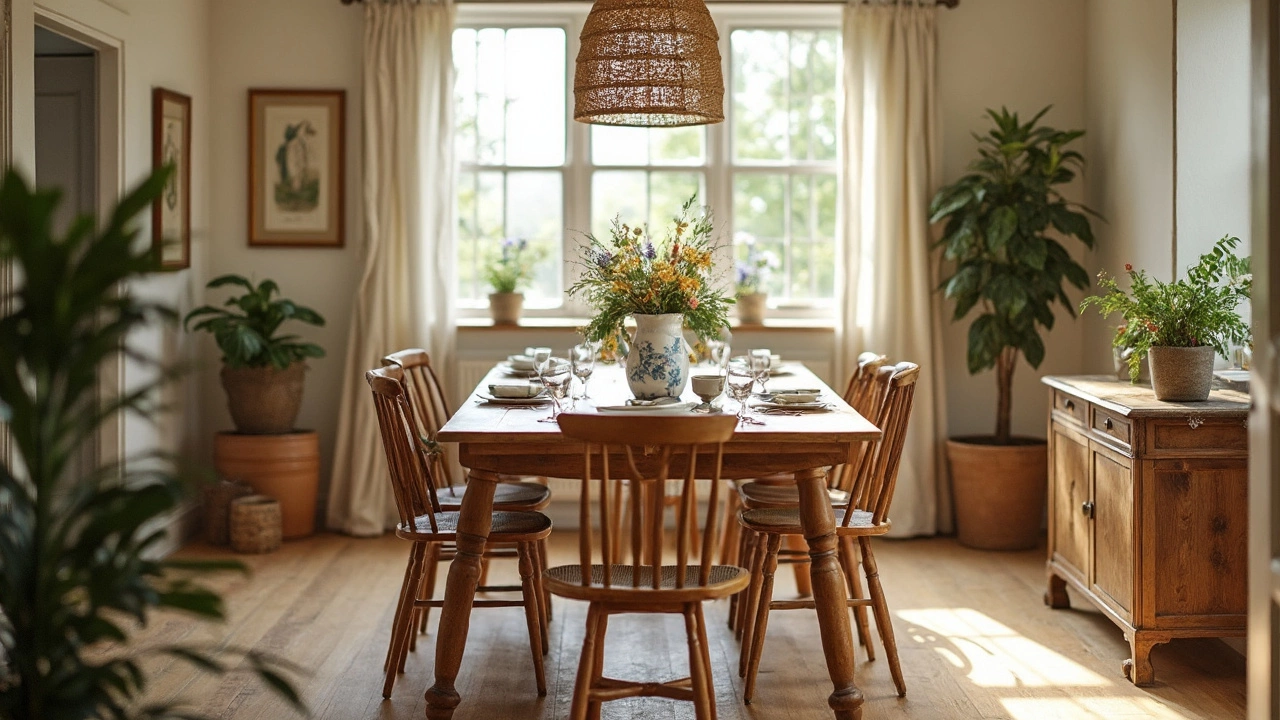If you’ve ever walked into a dining room and wondered, “What is the main piece of furniture actually called?”, you’re not alone. It’s the dining table that takes center stage. No matter how big or small the room is, the table is where everything happens—family dinners, homework, game nights, and way too many birthday cakes (trust me, I’ve wiped off enough frosting thanks to Clementine and Silas).
The dining table isn’t just a place to eat—it really is the heart of the dining room. In some cultures, people get a custom table for every new home. And did you know the world’s largest dining table can seat over 1,000 people? Most homes don’t need anything that dramatic, obviously. Still, getting the right table makes life easier. Round, rectangular, or extendable—the style you pick totally changes how the room feels and functions. Next, let’s break down what else you can expect to find around this main star of the dining space.
- What’s the Main Piece of Dining Room Furniture?
- Essential Dining Room Furniture Pieces
- Choosing the Right Dining Table
- Tips for Matching Dining Tables and Chairs
What’s the Main Piece of Dining Room Furniture?
When most people hear “dining room,” they think of the dining table. This main piece is where everyone gathers for meals, chats, and, honestly, lots of spills. The dining table has been a staple in homes for hundreds of years. In early homes, families often had just one big table that was used for eating, working, and pretty much everything else. Today, most dining tables are made from wood, glass, or metal and come in tons of shapes and sizes to fit any space.
Dining tables can be round, oval, rectangular, or even square. Each shape brings a different vibe. For example, round tables create a cozy feel and are great for small spaces. Rectangular tables are the most common choice in the U.S., especially if you’ve got a bigger family or like to host guests.
Here’s a look at typical dining table measurements for different group sizes:
| Seats | Recommended Table Size | Typical Shape |
|---|---|---|
| 2-4 | 30-40 inches | Round/Square |
| 4-6 | 40-60 inches | Rectangular/Round |
| 6-8 | 60-80 inches | Rectangular/Oval |
| 8-10 | 80-100 inches | Rectangular/Oval |
The dining table's height is usually around 28-30 inches, which seems like a random number until you notice it's the perfect height for both kids and adults to eat comfortably. Some people go for an extendable table so they can squeeze in a few extra guests at Thanksgiving (been there, done that—Maxwell’s side of the family is huge).
If you’re short on space, there are clever designs like drop-leaf tables or wall-mounted options. For bigger rooms, people sometimes opt for a statement piece with chunky legs or unique shapes. But at the end of the day, the most important thing is that your dining table suits your life—whether it’s dinner for two or a pizza party for ten.
Essential Dining Room Furniture Pieces
When you step into a typical dining room, the dining table is basically shouting, “Hey, look at me!” But that’s just the start. There’s a lineup of other key pieces that make this space practical and inviting. Here’s what usually fills out a dining room beyond the table.
- Dining chairs: Most standard dining tables are surrounded by four to eight chairs. Some people mix things up with benches or swap ends for armchairs—great for a bit of comfort or style.
- Buffet or sideboard: This is the long, low piece up against the wall. It holds dishes, serves as a mini serving station at big family dinners, and hides all that random tableware you don’t use daily.
- China cabinet or hutch: People who love to collect dishes or glassware usually have one of these. It’s a space to show off your favorite sets or keep special items safe from the kids (Clementine loves poking around in mine, so I totally get the need for glass doors).
- Bar cart: In some homes, a bar cart rolls out for parties or weekend hangouts. It’s a movable piece that keeps drinks or snacks within easy reach—plus, it just looks cool.
Here’s a quick look at how common these items are in North American dining rooms, based on a 2024 home design survey:
| Furniture Piece | Percentage of Homes |
|---|---|
| Dining Table | 99% |
| Dining Chairs | 96% |
| Buffet/Sideboard | 54% |
| China Cabinet/Hutch | 37% |
| Bar Cart | 21% |
Picking and arranging these pieces comes down to space. In tight dining rooms, a small sideboard or a few stackable chairs make a difference. If you’re hosting bigger groups often, going for a solid buffet or a longer table takes priority. And if you ever need an extra spot for holiday décor or piles of school projects, these pieces end up more useful than you might think. Every item should pull its weight, whether you’re serving steak dinners or just storing that endless supply of napkins.

Choosing the Right Dining Table
Picking the right dining table isn’t just about picking what looks pretty in a catalog. Space, shape, and how you actually live all matter. Let’s be real—if your home ends up like mine, with kids spreading out school projects and your partner reading the news before dinner, you need something that works for everything and everyone.
Start by measuring your dining room or space. Leave at least 36 inches between the table edge and the nearest wall or furniture—enough elbow room for chairs and for people to walk by. When it comes to shapes, here are some basics:
- Rectangular tables: Great for most rooms, especially if you have a big family or love inviting friends over. They fit more people longways and are easier to squeeze into narrow rooms.
- Round tables: Perfect for tight spaces or cozy, casual meals. There are no sharp corners, so it’s safer for little ones. Round tables also help conversation flow since everyone can see each other.
- Square tables: These fit well in square rooms or make sense for couples and smaller families, but you might run out of space with extra guests.
- Extendable tables: The best bet if your lifestyle flips between quiet weeknights and hosting the whole neighborhood. You can pop in an extra leaf when you need more room, and shrink it back down after.
Table height usually runs around 28–30 inches from ground to tabletop. That’s comfortable for most folks, even if you shift between regular dinners, work, or arts and crafts. Dining tables come in all sorts of materials—wood (most common), glass (modern style, but fingerprints show up), metal, or even marble. Wood’s solid and classic, while glass tops make a small room look bigger.
Wondering how many people you can fit at a table? Here’s a quick guide:
| Table Shape | Length (in) | Seats |
|---|---|---|
| Rectangular | 60–72 | 6–8 |
| Rectangular | 72–96 | 8–10 |
| Round | 48 | 4–6 |
| Round | 60 | 6–8 |
| Square | 36–44 | 4 |
A neat tip: always check if your dining chairs fit under the table, especially if you’re mixing and matching. And if you’re buying for kids like Clementine and Silas, consider tables with rounded edges—less drama if someone bumps a corner.
Here’s the deal: don’t get swept up by what looks good online. Think about your space, your lifestyle, and the chaos or calm your family brings to dinner time. The right table should handle everything—meals, projects, and all those everyday moments in between.
Tips for Matching Dining Tables and Chairs
The table might take center stage, but if your chairs don’t match, the whole vibe feels off. The trick isn’t about buying a matching set and calling it a day (unless you want no surprises). There’s room to get creative, but it helps to know a few basics so your dining room feels comfortable and inviting.
- Dining table height matters. Standard tables are about 30 inches high. Most dining chairs are 18 inches from floor to seat, making the gap just right for most adults—enough knee room, but not so low you feel like a kid at the grown-ups' table.
- Legroom is gold. Chairs fit best when there’s about a 12-inch gap between the seat and the underside of the table. Fancier tables with thicker aprons (that support piece underneath) chop things tighter, so check before you buy.
- Style doesn’t always mean “matchy-matchy.” Look for a common detail—maybe the chair legs are the same color as the table top or you repeat one material, like oak or metal. This little trick pulls the space together without looking too samey.
- Pay attention to comfort. Some chairs look cool but are a literal pain—too hard, too skinny, or backs angled weirdly. If you eat at home a lot, never skip the “sit test” before buying.
So, how many chairs fit around a standard table? Check this quick guide:
| Table Length | Recommended Chairs |
|---|---|
| 48 inches (4 ft) | 4 |
| 60 inches (5 ft) | 6 |
| 72 inches (6 ft) | 6-8 |
| 96 inches (8 ft) | 8-10 |
You don’t have to stuff the maximum number, though. It’s way better to have elbow room than a crammed party. We have a six-seater and, honestly, even with just four at the table, it feels cozy, not crowded.
If you have young kids like Clementine and Silas, pick chairs that are easy to wipe down and have some heft, so they don’t tip over when the little ones get wiggly.
 EN
EN
 HR
HR
 AR
AR

